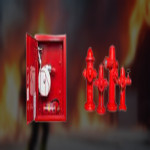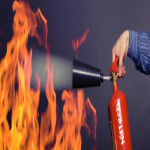Class A fires are the easiest to set out. They involve solid materials like wood, paper, plastic, or clothing.
Class A fires are the most ordinary type of fire and the type that most of us are friendly with. They involve solid flammable materials such as wood, paper, cloth, trash, or plastic.
You might start Class A fires purposefully when lighting a match or starting a bonfire. An unintended Class A fire could result from hitting a candle, a lost spark from a fireplace, or a lightning strike on a tree.
Luckily, Class A fires are the most comfortable type to extinguish. The Fire Equipment Manufacturer's Association suggested utilizing a water or foam fire extinguisher on Class A fires. You can also utilize water to extinguish the fire, as it can remove the fire's heat force.
Class B fires involve flammable liquids like oil, alcohol, or gasoline.
According to the US Fire Administration, Class B fires contain flammable liquids or gases like petroleum grease, alcohol, paint, propane, or gasoline. But, this category generally does not contain fires affecting cooking oils or grease.
According to Strike First, these types of fires might occur anywhere flammable liquids or gases are stored or utilized.
It's very important not to utilize a water extinguisher on a Class B fire — the stream of water might outstretch the flaming material rather than destroy it.
ACCORDING TO THE FIRE EQUIPMENT MANUFACTURER'S ASSOCIATION, Class B fires should be extinguished using foam, powder, or carbon dioxide extinguishers. These types of extinguishers work by cutting off a fire's oxygen supply.
Class C fires involve a source of electricity.
Class C fires, referred to as Class E in Australia, involve electrical equipment. This type of fire might be activated by old wiring in walls, frayed electrical cables, worn-out breaker boxes, or defective appliances.
Electrical fires are common in both homes and industrial settings. According to Strike First, the first thing you should try to do if an electrical fire starts is to disconnect the device or item from its power source just if it is secure to do so.
If likely, you should try to extinguish the flames utilizing a carbon dioxide or dry powder fire extinguisher. If and when the power source is detached, the fire can become a different class of fire, generally Class A.
Do not try to put out an electrical fire with a water or foam extinguisher, as both of those materials can perform electricity and potentially make the situation more hazardous.
Class D fires are rare, but can happen when a metal ignites.
It takes high levels of heat to ignite most metals, which creates Class D fires pretty rare outside of laboratories and industrial settings. According to the University of Massachusetts Boston's Office of Environmental Health and Safety, Class D fires are constantly generated by alkali metals such as potassium, magnesium, aluminum, and sodium, as these can kindle when revealed to air or water.
Although you're unlikely to face a Class D blaze in your home, the Fire Equipment Manufacturer's Association suggests extinguishing these types of fires with a dry powder extinguisher only.
Dry powder extinguishers work on metal fires by dividing the fuel from oxygen or removing the heating component of the blaze, but foam or water extinguishers can potentially raise the intensity of the flames and cause dangerous outbreaks, according to Imperial Systems.
Some fires might also be termed Class K or Class F if they contain cooking oils such as vegetable oil or animal fats.
Although they occasionally occur in Class B fires, the US Fire Administration considers blazes involving cooking oils to be in their own class, generally directed to as Class K or Class F in the UK.
Because of the high flash point of cooking oils and fats, Class K fires often start when a pan is left unaccompanied for too long on a stove. If probable, you'll want to turn off the heat on your cooking appliance and remove the fire from the heat origin as soon as attainable.
Just as you shouldn't utilize water to try and extinguish a Class B fire, extinguishing a cooking oil fire with liquid is possible to create a hazardous splatter effect and the flames.
Rather, you should extinguish a Class K fire with a wet chemical extinguisher, according to the New York City Fire Department. These are required in many commercial kitchens and are a good investment if you do any amount of cooking at home.




